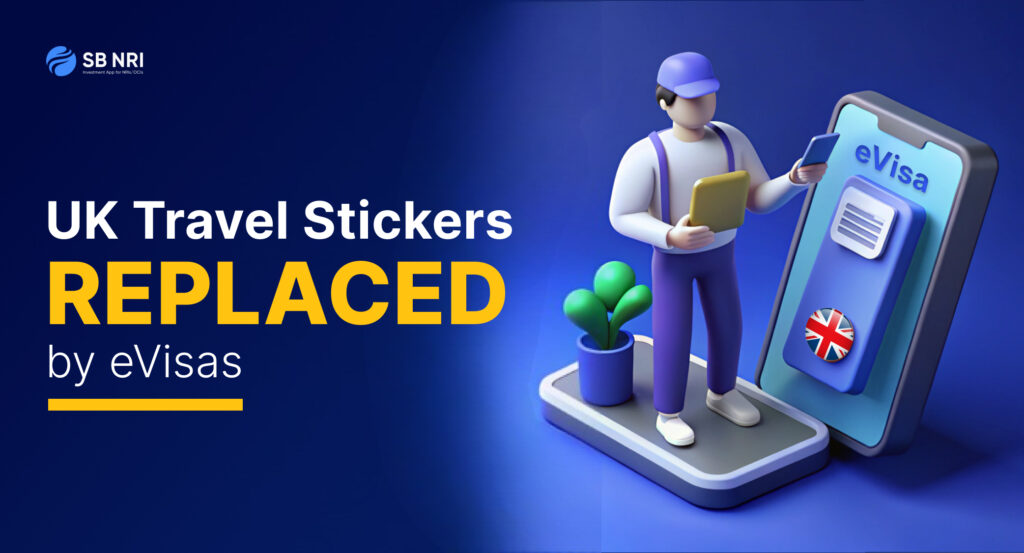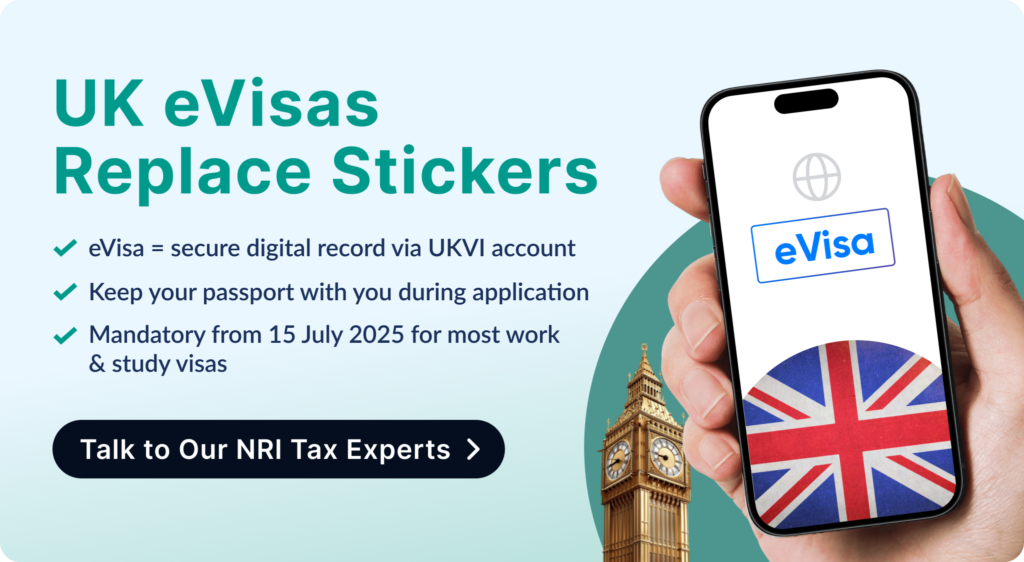
For years, applying for a UK visa meant giving up your passport, waiting for a vignette sticker to be placed inside, and only then preparing for travel. Many travelers applying for work or study visas often faced delays, heavy paperwork, and unnecessary stress.
That experience is now changing. The UK Home Office is transitioning to a digital immigration system, phasing out most physical visa documents by 2025. As part of this shift, vignette stickers are being replaced with UK eVisas, which are secure digital records of immigration status.
For all non-UK/Irish nationals, this means greater convenience, fewer delays, and more peace of mind when planning trips to the UK.
What is an eVisa?
Think of an eVisa as your visa, but completely digital. Instead of a sticker in your passport, all your details are stored safely online in your UKVI account.
Your eVisa tells you:
- What type of visa you have
- What you are allowed to do in the UK, such as work or study, and how long you can stay
- The start and end dates of your visa
The best part is that you can log in to your account anytime to check your status. If you need to prove it to an employer, university, or landlord, you can simply share it online through the UKVI platform. No more worrying about losing a sticker or carrying extra papers.
What If You Already Have a Visa Sticker, BRP, or BRC?
If you currently hold a vignette, Biometric Residence Permit (BRP), or Biometric Residence Card (BRC), here’s what you should know under the UK’s new digital system:
- You can still use your current documents, and updating to an eVisa does not affect your immigration status or conditions.
- The Home Office requires BRP and BRC holders to create a UKVI account. The Home Office began inviting them from April 2024, with full access available from summer 2024. If you haven’t already, you must now create your UKVI account to access your eVisa.
- Border officials no longer accept expired permits. Up until 1 June 2025, certain expired permits could still be used for right-to-work or rent checks, and some were accepted for travel if the visa status was current. However, from 2 June 2025, expired permits are no longer accepted at the border. To re-enter the UK, you must use your eVisa.
- The Home Office advises vignette holders to consider a “No Time Limit” (NTL) application. While old vignette stickers and legacy stamps remain valid proof of status, shifting to an eVisa ensures you are fully aligned with the UK’s digital immigration system.
Why This Matters for Global Travelers
For NRIs and OCIs, and other foreign nationals, this change is more than just a technical update. It directly improves how you plan and manage your travel to the UK.
Here’s why UK eVisas make a real difference:
- Keep your passport with you: No more leaving your passport at the Visa Application Centre for weeks. This means you can continue to travel, use it for ID, or handle any urgent paperwork while your visa application is being processed.
- Your status is more secure online: Unlike a paper sticker that can fade, tear, or even get misplaced, your UK eVisa is stored securely in your UKVI account. As long as you can log in, you will always have access to it.
- Travel becomes less stressful: Airlines and UK border officers check your status electronically before you even board the flight. That cuts down the chance of last-minute problems at check-in or immigration.
- Sharing your visa is simpler: You can generate a secure share code in your UKVI account to prove your status, commonly used for right to work or right to rent checks.
- Fewer delays and less stress: For NRIs and OCIs who often juggle multiple trips between India, the UK, and other countries, not having to wait for a vignette sticker means more flexibility in planning flights and commitments.
Who Will Receive an eVisa?
- From 15 July 2025, most work and study visa applicants will receive eVisas instead of vignette stickers.
- Exceptions for now: Dependents, short-term visitors, and some other categories will still receive vignette stickers.
- Already in effect: BRPs and BRCs are no longer issued.
- Bigger picture: These updates are part of the UK’s plan to move to a fully digital immigration system by 2025.
How to Use Your eVisa
The process of applying for and using a UK eVisa is quite straightforward, especially compared to the older vignette system. Here’s what the process looks like:
- Apply online at gov.uk.
Submit your application through the official UK portal (gov.uk).
- Biometrics at a Visa Application Centre (if required).
You may still need to attend a Visa Application Centre (VAC) to provide biometrics, but the big change is that you can now keep your passport with you instead of handing it over.
- Get your decision and access your eVisa.
Once approved, log in or create your UKVI account to view your UK eVisa details.
- Link your passport.
Before travelling, ensure your passport details are correctly linked to your eVisa in your UKVI account. This ensures airlines and UK border officials can verify your status electronically.
- Travel and entry to the UK.
When you arrive, your UK eVisa will be used as proof of immigration status. You don’t need to show a vignette or paper document.

Life in the UK with an eVisa
Once you’ve arrived in the UK, your eVisa becomes your main proof of immigration status. You can use it to:
- Prove your right to work when joining a new employer
- Show your right to rent when securing accommodation
Your eVisa is your official digital record. It is directly used for right-to-work and right-to-rent checks, and certain public bodies can access your status when required. For services like healthcare or banking, you may still need to provide additional documents such as proof of identity or residence.
Pro Tip: Always keep your UKVI account details up to date. If you renew your passport, make sure you update your UK eVisa with the new passport number. Otherwise, your status might not show correctly during checks.
Conclusion
The UK’s move to eVisas is a major step toward a fully digital immigration system by 2025. For all foreign nationals, including NRIs and OCIs, the benefits are clear:
- No need to surrender passports during applications
- Easier travel with electronic checks at airlines and borders
- A single, secure digital record that can be accessed and shared anytime
So, if you are applying for a UK work or study visa after 15 July 2025, expect to receive an eVisa instead of a vignette.
While your UKVI account manages your immigration status, SBNRI helps you manage your Indian income, tax, and investments digitally.
Your mutual fund account is ready. Open the SBNRI app and make a one-time investment in any fund to experience the complete journey once your KYC is completed.
If you are applying for a UK visa in the coming months, get ready for this change and take advantage of the convenience that a digital visa offers. To make your financial journey equally stress-free, talk to our tax experts at SBNRI.
Frequently Asked Questions (FAQs)
1. What is a UK eVisa?
A UK eVisa is a secure digital record of immigration status, replacing physical visa stickers and Biometric Residence Permits (BRPs).
2. Who will get a UK eVisa?
From 15 July 2025, most applicants for UK work and study visas will receive eVisas. Other visa categories will move to digital records in phases.
3. What happens if I already have a visa sticker, BRP, or BRC?
Your current documents remain valid as proof of status. However, expired BRPs/BRCs are no longer accepted for travel from 2 June 2025 onwards. To re-enter the UK, you must use your eVisa via your UKVI account.
4. Will dependents and short-term visitors still get vignette stickers?
Yes, for now. Dependents, short-term visitors, and some other categories continue to receive vignette stickers during the transition period.
5. How do I access my UK eVisa?
You must create a UKVI account at gov.uk. Once your visa is approved, your eVisa details are available online. You can also generate a share code to prove your right to work, study, or rent in the UK.
6. How do eVisas benefit Indian applicants (NRIs & OCIs)?
For Indian applicants, including NRIs and OCI cardholders, eVisas mean faster processing, no need to surrender passports, and secure online storage of visa details.
7. What should I do if my passport changes?
If you renew or change your passport, you must update the new details in your UKVI account to ensure your eVisa is linked correctly.



